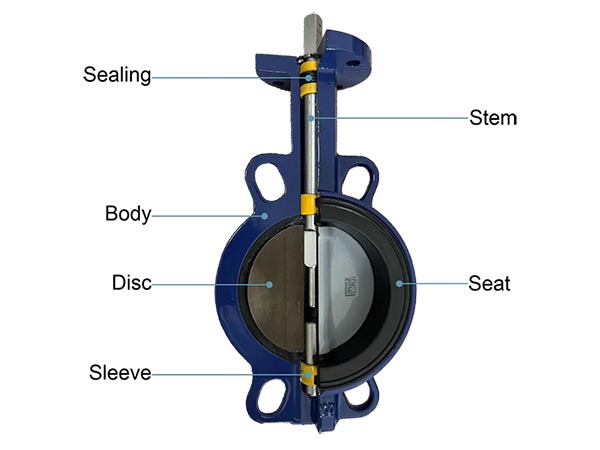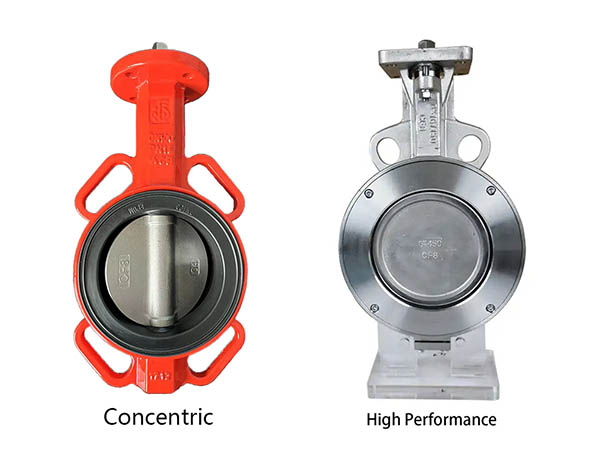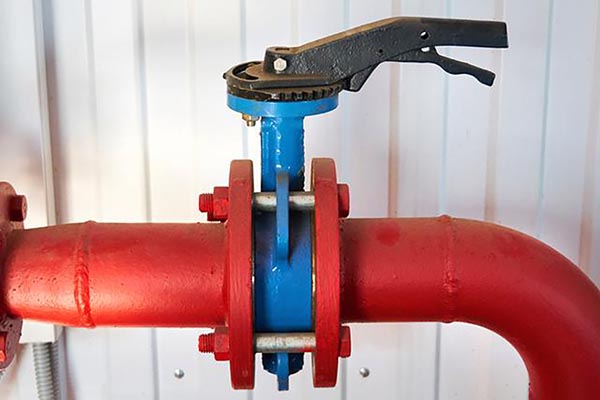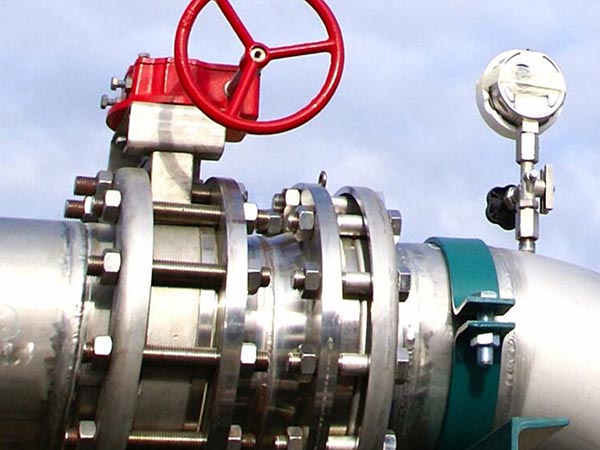Butterfly valves are used to start, stop or regulate the flow of liquids or gases through pipes. They get their name from the wing-like disc that pivots within the valve body, resembling the movement of a butterfly. Among the different types of butterfly valves, high performance butterfly valves (HPBV) and concentric butterfly valves are the two most common designs. This comparison will break down the differences between the two from multiple dimensions to clarify their roles in industrial and municipal applications.
| Feature | Concentric Butterfly Valve | High-Performance Butterfly Valve |
| Design | Central stem and disc | Offset stem with metal seat |
| Sealing Mechanism | Soft elastomeric seat | RPTFE seat |
| Pressure Rating | Up to 250 PSI | Up to 600 PSI |
| Temperature Rating | Up to 180°C (356°F) | Up to 260°C (536°F) |
| Wear & Tear | Higher due to seat contact | Lower due to offset design |
| Application Suitability | Low-pressure fluids | Medium-pressure, high-temp fluids |
| Cost | Lower | Higher |
1. Design and Construction
The core difference between concentric butterfly valves and high-performance butterfly valves lies in their structural design, specifically the position of the valve stem and valve disc relative to the valve body and the materials used.
1.1 Concentric Butterfly Valves

The concentric design is known as a "zero offset" or "resilient seat" valve, aligning the valve stem and valve disc directly to the center of the valve body and pipe bore. This center alignment has no deviation.
1.1.1 Disc Movement
The disc rotates 90° around the axis of the valve stem, and moves from fully open (parallel to the pipe) to fully closed (perpendicular to the pipe) throughout its range of motion.
1.1.2 Sealing Mechanism
The seal is achieved by an interference fit between the edge of the valve disc and the resilient rubber-like valve seat (such as EPDM, acrylic or fluororubber) lining the inner surface of the valve body.
1.1.3 Materials
The valve body is usually made of high-strength and corrosion-resistant materials such as cast iron, ductile iron or even stainless steel for less demanding applications, because the rubber valve seat prevents fluid contact with the valve body.
The disc may be stainless steel, aluminum bronze, coated ductile iron, or fully lined with metal, depending on the corrosiveness of the fluid.
1.2 High-Performance Butterfly Valves

Typically a double-offset design with two key offsets:
The stem is located behind the disc rather than through the center of the disc, and
The disc and stem assembly is offset from the centerline of the pipe bore.
Some advanced versions include triple offsets, but double offset is standard on high-performance models.
1.2.1 Disc Movement
Due to the offset, the disc rotates in a cam-like action, reducing contact with the seat.
1.2.2 Sealing Mechanism
The seat is made of more durable materials, such as reinforced Teflon, to withstand higher pressures and temperatures. Unlike the rubber seat in a concentric valve, the seal is tighter and less dependent on deformation.
1.2.3 Materials
The body and disc are made of strong metals, such as stainless steel, carbon steel, or alloys, to withstand harsh conditions.
1.3 Summary: Design Implications
The simplicity of the concentric valve makes it lightweight and compact, making it ideal for direct installation. However, its reliance on a deformable rubber seat limits its flexibility.
The offset design and stronger materials of high-performance valves enhance their durability and adaptability, but at the expense of increased complexity and weight.
---
2. Performance Capabilities
Performance is the most variable aspect of these valves and the one that users value and care about the most. Specifically, it is analyzed in terms of pressure, temperature, sealing effect and service life.
2.1 Concentric Butterfly Valves
2.1.1 Pressure Ratings
Concentric butterfly valves can generally withstand pressures up to PN16, but this varies depending on size and material. Above this pressure, the rubber seat may deform or fail.
2.1.2 Temperature Ratings
The maximum temperature is 356°F (180°C), limited by the thermal limits of the rubber or PTFE seat. High temperatures will degrade the performance of the elastomer and impair the sealing.
2.1.3 Sealing performance
It can provide reliable closure in low-pressure systems, but the continuous friction between the valve disc and the valve seat will cause wear, which will reduce effectiveness.
2.1.4 Throttling
Since butterfly valves are more suitable for full opening and closing, if they are used for flow regulation, long-term throttling will accelerate the wear of the valve seat, making it less accurate and durable.
2.1.5 Durability
Being more elastic, metal or reinforced valve seats are more durable than rubber. The offset design further extends the service life by limiting friction.
2.2 High-performance butterfly valve
2.2.1 Pressure rating
Due to its rugged structure and offset design that reduces stress on the valve seat, it can withstand pressures up to PN16.
2.2.2 Temperature rating
Since the valve seat uses RPTFE, it can operate effectively at temperatures up to 536°F (280°C).
2.2.3 Sealing performance
Due to the precise fit of the offset valve disc and the durable valve seat, leakage is almost zero and is usually close to airtight closure. This makes it ideal for critical applications.
2.2.4 Throttling
The construction and materials used in high-performance butterfly valves enable them to precisely control flow even at high pressures. Reduced seat contact minimizes wear and maintains seal integrity over multiple cycles.
2.2.5 Durability
Being more resilient, metal or reinforced seats are more durable than rubber. The offset design further extends service life by limiting friction.
2.3 Summary: Performance Highlights
Concentric valves are suitable for low-pressure, stable conditions, but fail at medium and high pressures.
High-performance valves offer superior reliability and service life at a higher initial cost.
---
3. Applications
The choice between midline butterfly valves and high-performance butterfly valves depends on the specific needs of the system in which they are installed.
3.1 Concentric Butterfly Valves
For low to medium pressure/temperature systems where cost and simplicity are priorities.
Common Uses:
- Water and Wastewater: Municipal water mains, irrigation and sewage systems benefit from their economy and fluid isolation.
- Food and Pharmaceutical: Rubber seats prevent sensitive fluids from being contaminated by the valve body.
- Gas Supply: Low-pressure gas lines use it for on/off control.
- Fire Protection: Sprinkler systems take advantage of its fast operation and reliability at medium pressures.
- Low-Pressure Steam: For steam up to 250 PSI and 350°F.
3.2 High-Performance Butterfly Valves
For low-medium pressures or critical systems requiring precision and durability.
Common Uses:
- Oil and Gas: Handles harsh chemicals, petrochemicals, and offshore conditions with high pressures and corrosive fluids.
- Power Generation: Manages high-pressure steam and cooling water in turbines and boilers.
- Chemical Processing: Resists corrosive fluids and maintains tight shutoff in volatile environments.
- HVAC: For large systems requiring precise flow control.
- Shipbuilding: Withstands marine conditions and high-pressure fluid management.
3.3 Application Overlap and Differences
While both valves regulate flow, concentric valves dominate in cost-sensitive, less demanding environments, while high-performance valves are preferred for industrial processes where failure can have serious consequences.
---
4. Operational Considerations
In addition to design and application, practical factors such as installation, maintenance, and system fit integration also play a role.
4.1 Installation
- Concentric: Simpler installation due to lighter weight and simpler flange compatibility.
- High-performance: Precise alignment is required due to the offset design, and its weight requires stronger support.
4.2 Maintenance
- Concentric: Maintenance focuses on replacing the rubber seat, which is a relatively quick and inexpensive repair method. However, frequent wear may increase downtime in high-cycle systems.
- High-performance: Maintenance is less frequent due to the durable seat, but repairs (e.g., replacing the seat) are more expensive and technical, usually requiring professional maintenance personnel with specialized tools.
4.3 Pressure Drop
- Concentric: Centered discs create more turbulence when partially open, reducing efficiency in throttling applications.
- High Performance: Offset discs improve flow characteristics, reducing cavitation and pressure drop, especially at high speeds.
4.4 Actuation
Both valves can be used with manual, pneumatic, or electric actuators, but high-performance valves are often paired with advanced controls for precise automation in industrial settings.
---
5. Cost and Life Cycle Analysis
5.1 Initial Cost
Concentric valves are significantly cheaper because they are relatively simple to build and use less material. This is not the case with high-performance butterfly valves.
5.2 Life Cycle Cost
High-performance valves are generally more economical over time because they are less frequently maintained and replaced. In critical systems, their reliability can also reduce downtime costs.
---
6. Conclusion: Summary of Advantages and Disadvantages
6.1 Concentric Butterfly Valve
6.1.1 Advantages:
- Cost-effectiveness: Lower manufacturing and material costs give it a budget advantage.
- Simple design: Easy to install, operate, and maintain, with fewer moving parts.
- Fluid Isolation: Rubber seats protect the valve body, allowing the use of cheaper materials and maintaining fluid purity.
- Lightweight: Ideal for applications where weight is a concern.
6.1.2 Disadvantages:
- Limited range: Upper limits are 250 PSI and 356°F, limiting its use to harsh conditions.
- Susceptible to wear: Constant seat friction can lead to degraded performance, requiring more frequent maintenance.
- Poor high-pressure throttling performance: Loses precision and sealing under pressure.
6.2 High-Performance Butterfly Valves
6.2.1 Advantages:
- High Capacity: Can handle medium to high pressures (up to 600 PSI) and temperatures (up to 536°F).
- Long Service Life: Reduced seat wear and durable materials extend service life.
- Precision: Excellent throttling and shutoff even in demanding conditions.
- Versatility: Suitable for a wide range of fluids and environments.
6.2.2 Disadvantages:
- Higher Cost: Expensive materials and complex design increase upfront investment.
- Complexity: Installation and repair require more expertise.
- Weight: Heavier construction may complicate retrofitting of some systems.
Concentric butterfly valves and high-performance butterfly valves serve overlapping but different areas in fluid control. The zero-offset rubber seat design of the concentric valve makes it a practical and affordable choice for moderate applications such as water supply, food processing or fire protection. If performance and resilience are non-negotiable, then the high-performance butterfly valve is the answer. For buried applications (such as underground pipelines), both methods can be used, but the lighter weight and lower cost of the concentric valve usually prevail unless extreme conditions require otherwise.



